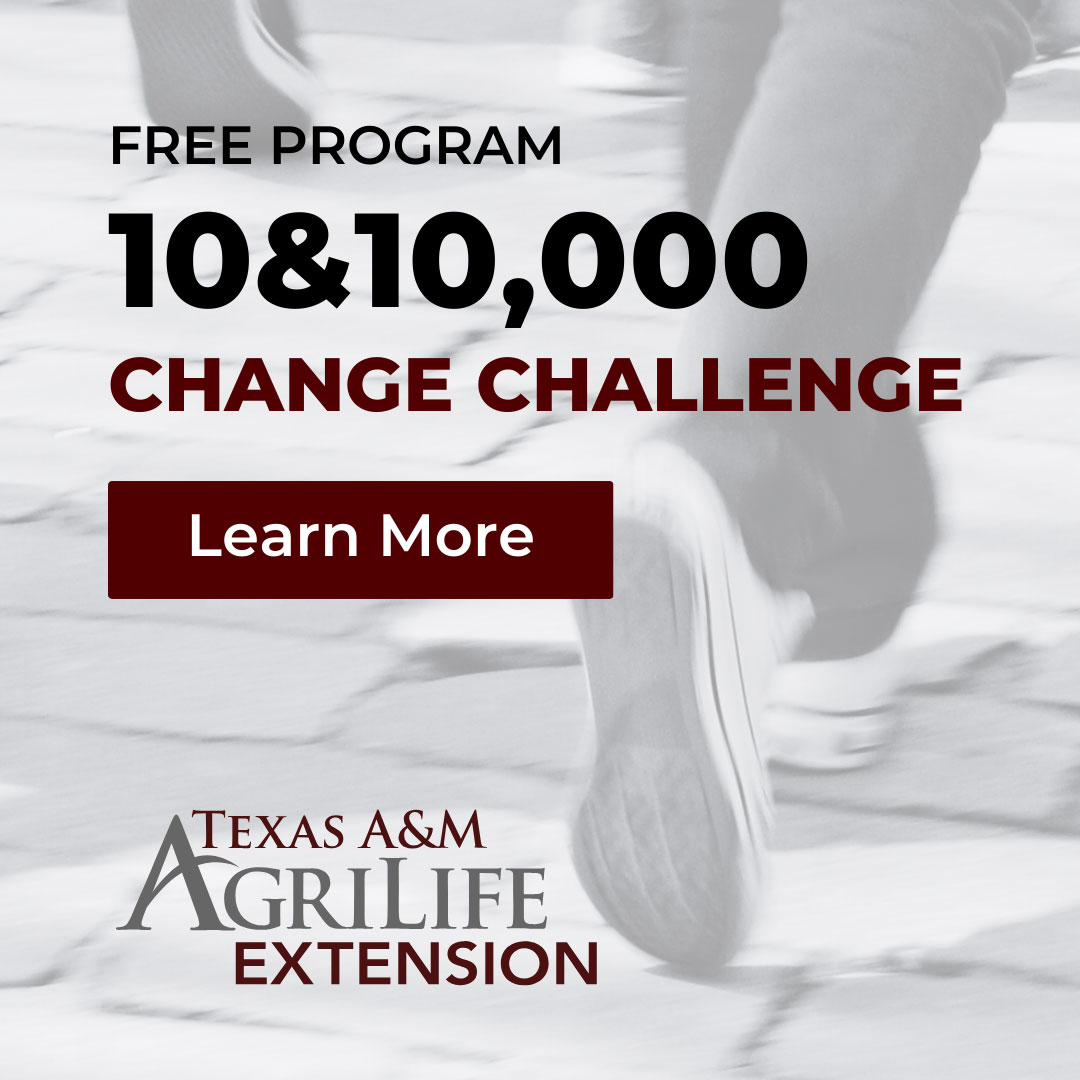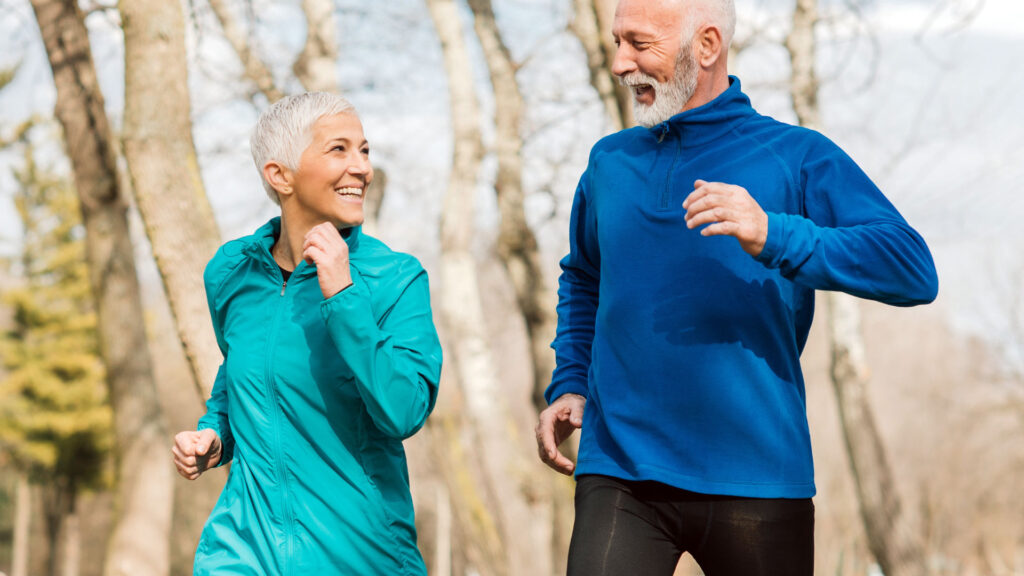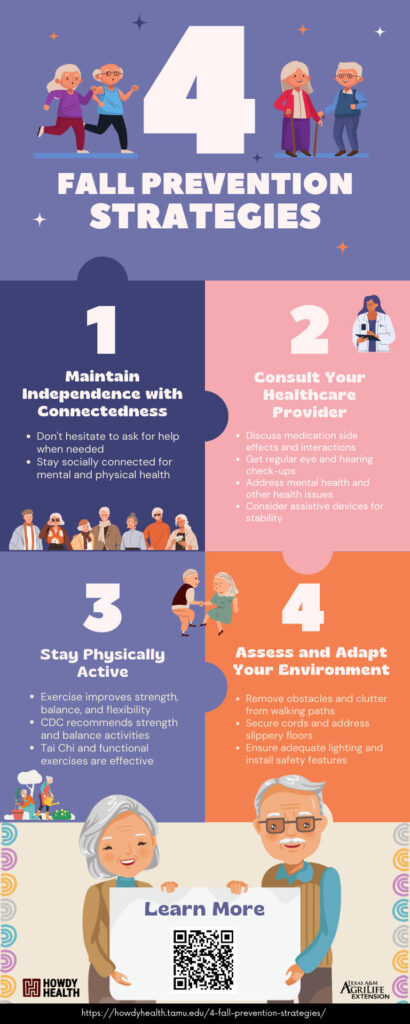In the US, falls are the leading cause of injury and injury death among older adults (age 65 and older), causing about 3 million emergency room visits and over 36, 000 deaths each year… not to mention $50 billion in medical costs.1,2,3 Unfortunately, falls – and the injuries and deaths they cause – are also increasing.3
Fall Statistics
- 1 out of 4 older adults in the US falls each year2
- 1 out of 5 falls causes a serious injury (e.g., broken bone[s] or head trauma/brain injury)2
- With age, the risk of falling increases and the ability to bounce back after falling decreases.4
- Falls among older adults can reduce their ability to remain independent.3
- Falls among older adults can lead to reduced quality of life, reduced mobility, permanent disability, prolonged hospitalization, and nursing home admission.5,6,7

Fall Prevention Strategies
Falls don’t have to be inevitable as you age – falls can be prevented!3 Fall prevention can help all of us, and especially older adults, who may begin to restrict their activity due to fear of falling8 or a past experience with an injury or fall.
Whether you are reading this because you want to reduce your risk of falling, or help a loved one do so, focus on the following 4 fall prevention strategies:
1. Focus on the goal
The goal of fall prevention strategies is to maintain the best quality of life with the most independence possible. Independence doesn’t mean doing everything by yourself. Social connectedness and support are foundational for our overall health, at every age and stage.
- Don’t be afraid to ask for help. If you need to move something heavy, get something from a high shelf, retrieve something from your attic, or use a ladder for outdoor work, don’t hesitate to ask for help. Asking for help to reduce fall risk is less an act of dependence and more an act of wisdom (for staying independent). Remember that a fall can result in injury that will likely require more help from others. Preventing a fall from happening will offer you the most independence.
- Stay connected with others. Social connectedness helps us when we need someone whom we can ask for help. It also keeps us from becoming inactive. By intentionally making plans with others, we’re not staying sedentary all the time. Going out and about, trying new things, and spending time with others can help keep our minds sharp and keep us mentally, emotionally, and physically healthy. If you need some suggestions, consider these ideas:
- Healthy cooking and baking
- Gardening
- Group sports, like golf and pickleball
- Outdoor adventures, like hiking and kayaking
- Crafts, like knitting and woodworking
- Group exercise, like water aerobics and dancing
- Arts, like painting and ceramics
- Book clubs
- Games, like card or board games
- Faith-based activities.5
2. Talk with your healthcare provider
Your health care provider can discuss the following issues that may influence your risk of falling:
- Medications: Taking any medication may increase your risk of falling. Medications can sometimes make us dizzy or drowsy. Be especially careful when starting a new medication. Talk with your provider about any potential side effects or possible interactions of your medications.9
- Vision: Be sure to have your eyes checked at least once a year and replace your eyewear, if needed. Low vision and other forms of vision loss can increase your risk of falling. In fact, people with vision loss are twice as likely to fall as those without visual impairment.9
- Hearing: Have a hearing exam each year. Untreated hearing loss can cause balance issues that can lead to a fall.10
- Mental health: Stay connected with family and friends. Do things you enjoy. Being inactive can lead to loss of muscle strength and balance. Fear of falling may compromise social interaction, increasing risk for isolation, depression, and anxiety,8 which may also increase your risk of falling.10
- Other health issues: Discuss how to treat any other health problems that may result in pain, muscle weakness, and/or instability (e.g., arthritis, chronic pain, trouble sleeping, etc.),11 which may contribute to fall risk.
- Assistive devices: Don’t shy away from using assistive devices (e.g., walkers, canes, reaching aids, etc.) that can help you remain stable, fall-free, and as independent as possible. Ask your health care provider if there are assistive devices that would be appropriate for you.11
3. Be physically active
Your strength and range of motion benefit from being physically active. While we do lose muscle as we age, exercise can help restore some of that strength and flexibility. Even if you’ve been sedentary your whole life, becoming active now will benefit you in many ways – including protection from falls.9 In fact, a recent review of studies involving 25,160 participants confirmed that exercise prevents falls. In particular, when compared with a control group, the rate of falls was reduced by ~
- 24% with balance & functional exercises (Functional exercises work to strengthen the muscles you use for daily living and improve coordination, balance, range of motion, and body awareness, e.g., squatting, bending, reaching, pushing, pulling, and twisting)
- 28% with balance, functional, & resistance (strength) exercises
- 23% with Tai Chi
- 42% in interventions that included an exercise dose of 3+ hours per week with both balance and functional exercises.12
The Centers for Disease Control and Prevention suggests strength and balance activities at least 3 times a week to help reduce your risk of falling.10 The following resources can get you started with fall prevention exercises:
- Exercise for Balance and Fall Prevention13
- Exercises to Help Prevent Falls14
- Exercise to Prevent Falls15
- Fall Prevention: Balance and Strength Exercises for Older Adults16
- Four Types of Exercise Can Improve Your Health and Physical Ability17
- What Exercises Can Help You Prevent a Fall?18
Be sure to check with your health care provider before starting any new exercise program.
4. Assess & Adapt Your Environment
Removing hazards from your home and installing safety features can go a long way toward preventing falls. How safe is your home environment? Look at each room in your home and learn how to recognize and remove hazards that could cause you or your loved one to fall. Start by checking for the following issues and making appropriate repairs, adjustments, or installations:
- Remove obstacles or clutter from your walking paths; rearrange or remove items to create a clear path; secure electrical cords away from walking paths (do not put cords under a rug)
- Address slippery floors with non-skid wax or rubber-soled footwear, and remove or secure loose rugs with tacks or slip-resistant backing
- Check for uneven or raised floors; repair loose, wooden floorboards, cracked or raised tiles or other hard surface floors, and carpeting right away; mark edges of any steps with bright colored tape
- Use non-slip mats in the bathtub and/or shower, or use a bath seat
- Keep commonly used items within easy reach
- Make sure there is adequate lighting and that light switches are easily reachable; place nightlights in bedrooms, bathrooms, stairwells, and hallways
- Assess your needs and install safety bars and handrails in places like stairways, hallways, bathrooms, and bedside
- If using a step stool, be sure it has a non-slip surface and bar to hold onto when retrieving hard-to-reach items
- Install ramps and lifts in areas you find hard to negotiate.8,10,15,19,20
Look for these and other improvements that can make your home safer in the long run.
You can learn more about how to prevent falls, as well as what to do if you or your loved one falls, by participating in our A Matter of Balance program. A Matter of Balance is a nationally recognized, evidence-based fall risk reduction program that emphasizes practical strategies to reduce fear of falling and increase activity levels. Participants learn to:
- View falls and fear of falling as controllable
- Set realistic goals to increase activity
- Change their environment to reduce fall risk factors
- Exercise to increase strength and balance.
Contact your local Texas A&M AgriLife Extension Agent to see if they are offering A Matter of Balance in your area.
Infographic
Download the PDF or share the image below to help others learn 4 Fall Prevention Strategies.
- Kakara R, Bergen G, Burns E, Stevens M. Nonfatal and Fatal Falls Among Adults Aged ≥65 Years – United States, 2020-2021. MMWR Morb Mortal Wkly Rep. 2023 Sep 1;72(35):938-943. doi: 10.15585/mmwr.mm7235a1.
- Centers for Disease Control and Prevention. Keep on your feet-preventing older Adult Falls. March 24, 2023. Accessed October 2, 2023. https://www.cdc.gov/injury/features/older-adult-falls/index.html.
- Centers for Disease Control and Prevention. Older Adult Falls | Fall Prevention. April 12, 2023. Accessed October 2, 2023. https://www.cdc.gov/falls/index.html.
- Van Pelt J. Focus on Fitness: Fall Prevention via targeted exercisn – today’s Dietitian Magazine. Today’s Dietitian. Accessed October 2, 2023. https://www.todaysdietitian.com/newarchives/ND21p56.shtml.
- Centers for Disease Control and Prevention. Caregivers. September 12, 2023. Accessed October 2, 2023. https://www.cdc.gov/stillgoingstrong/caregivers/index.html.
- Gill T, Murphy T, Gahbauer E, Allore H. Association of Injurious Falls with Disability Outcomes and Nursing Home Admissions in Community-living Older Persons. Am J Epidemiol. 2013 Aug;178(3):418–25.
- Burns E, Kakara R. Deaths from Falls Among Persons Aged ≥65 Years—United States, 2007–2016. MMWR Morb Mortal Wkly. Rep. 2018 May;67(18):509–514.
- Texas A&M AgriLife Extension Service. A matter of balance. August 12, 2022. Accessed October 2, 2023. https://agrilifeextension.tamu.edu/asset-local/a-matter-of-balance/.
- Debunking the Myths of Older Adult Falls. The National Council on Aging. May 25, 2023. Accessed October 2, 2023. https://www.ncoa.org/article/debunking-the-myths-of-older-adult-falls.
- Centers for Disease Control and Prevention. My mobility plan – centers for disease control and prevention. Accessed October 2, 2023. https://www.cdc.gov/transportationsafety/pdf/older_adult_drivers/cdc-mymobilitytool.pdf.
- Manage Your Health to Prevent Falls. Ohio Department of Aging. Accessed October 2, 2023. https://aging.ohio.gov/care-and-living/health-and-safety/fall-prevention.
- Sherrington, C., Fairhall, N., Kwok, W. et al. Evidence on physical activity and falls prevention for people aged 65+ years: systematic review to inform the WHO guidelines on physical activity and sedentary behaviour. Int J Behav Nutr Phys Act 17, 144 (2020). https://doi.org/10.1186/s12966-020-01041-3.
- Kaiser Permanente. Exercise for balance and fall prevention – my doctor online. December 2021. Accessed October 2, 2023. https://mydoctor.kaiserpermanente.org/ncal/Images/010526-037CL_tcm75-574622.pdf.
- Exercises to help prevent falls: Medlineplus medical encyclopedia. MedlinePlus. Accessed October 2, 2023. https://medlineplus.gov/ency/patientinstructions/000493.htm.
- Ohio Department of Aging. Falls prevention at home. Accessed October 2, 2023. https://aging.ohio.gov/care-and-living/health-and-safety/fall-prevention/fall-prevention-at-home-1.
- Stutzman L. Fall prevention: Balance and strength exercises for older adults. Johns Hopkins Medicine. August 8, 2021. Accessed October 2, 2023. https://www.hopkinsmedicine.org/health/wellness-and-prevention/fall-prevention-exercises.
- Four types of exercise can improve your health and physical ability. National Institute on Aging. Accessed October 2, 2023. https://www.nia.nih.gov/health/four-types-exercise-can-improve-your-health-and-physical-ability.
- What Exercises Can Help You Prevent a Fall? The National Council on Aging. June 2, 2023. Accessed October 2, 2023. https://www.ncoa.org/article/what-exercises-can-help-you-prevent-a-fall.
- Fall prevention: Simple tips to prevent falls. Mayo Clinic. February 3, 2022. Accessed October 2, 2023. https://www.mayoclinic.org/healthy-lifestyle/healthy-aging/in-depth/fall-prevention/art-20047358?p=1.
- Steady u Ohio. Ohio Department of Aging. Accessed October 2, 2023. https://aging.ohio.gov/care-and-living/health-and-safety/fall-prevention/steady-u-ohio.




